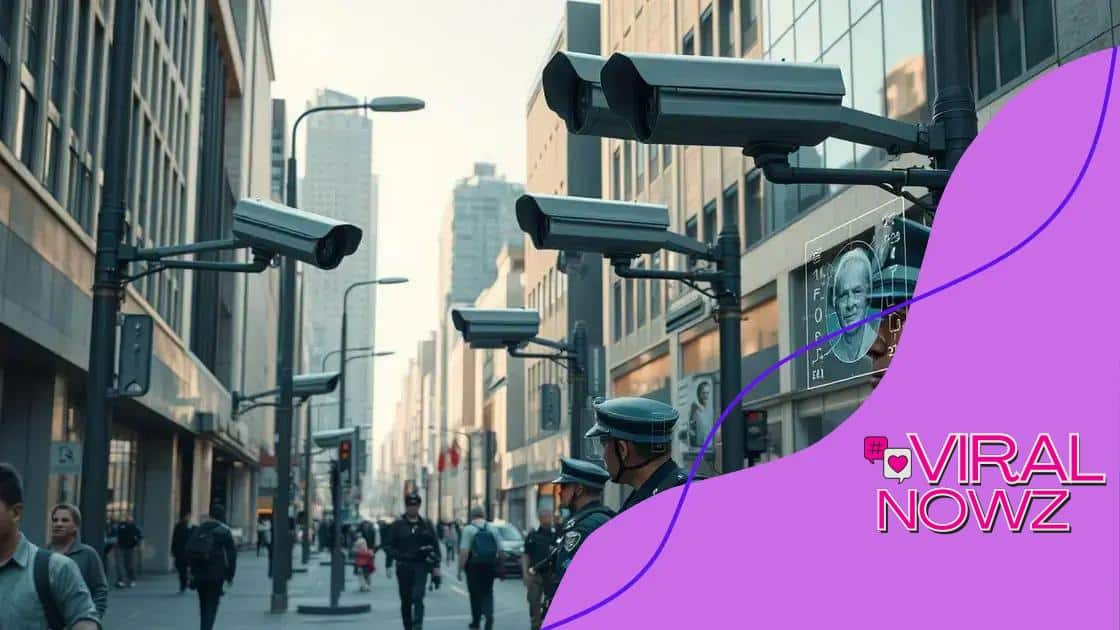The role of facial recognition in enhancing public safety

The role of facial recognition in enhancing public safety includes improved crime prevention, quicker suspect identification, and better resource allocation for law enforcement, while addressing privacy and ethical concerns is crucial for public trust.
The role of facial recognition in enhancing public safety is a hot topic these days. Have you ever wondered how this technology impacts our everyday lives? In this article, we’ll explore its benefits and potential concerns.
Understanding facial recognition technology
Understanding facial recognition technology is essential in today’s world. This advanced system allows computers to identify and verify individuals through their facial features. It is used in various fields, from security to marketing.
How It Works
The technology analyzes the unique patterns of a person’s face. First, it captures an image, then it creates a mathematical representation of the face. This data is compared to existing databases to find a match.
- Image capture through cameras
- Algorithms for feature extraction
- Database comparison for identification
Facial recognition involves two primary processes: detection and recognition. During detection, the system scans an image for faces. Once a face is detected, recognition algorithms assess the facial features.
Applications in Real Life
This technology has many applications. In law enforcement, it helps identify suspects in crowds. Airports use it to ensure security by quickly verifying identities. Retailers adopt it to enhance customer experiences by personalizing services.
- Crime prevention and investigation
- Secure access to devices
- Targeted marketing strategies
Facial recognition is not without its challenges. Privacy concerns arise about the use of personal data without consent. Misidentification can lead to false accusations, creating a need for responsible usage guidelines.
Benefits of facial recognition for public safety
Benefits of facial recognition for public safety are becoming increasingly clear as cities adopt this technology. This innovative tool brings numerous advantages that enhance security measures and improve responses to incidents.
Enhancing Crime Prevention
Facial recognition helps law enforcement quickly identify potential criminals. By scanning crowds at public events or busy areas, authorities can prevent crimes before they happen. This proactive approach allows for a safer environment.
- Identifying suspects in real-time
- Reducing crime rates through deterrence
- Streamlining investigations with quick identifications
Moreover, it enables better resource allocation for police forces. Agencies can direct patrols to areas with high crime risks, improving overall safety.
Speeding Up Emergency Responses
In emergency situations, every moment counts. Facial recognition assists security personnel in identifying individuals who may require immediate assistance. For example, it can help locate missing persons or alert officers to dangerous individuals, expediting response times.
- Quick identification of missing children
- Detecting known offenders in real-time
- Enhancing situational awareness for first responders
This technology does not just benefit law enforcement; it also helps community members feel safer. The presence of cameras equipped with facial recognition can deter criminal activity, fostering a sense of security in public spaces.
Supporting Community Initiatives
Facial recognition can also aid community outreach programs. By analyzing data on crime patterns, cities can engage residents in safety initiatives. Informed communities can work together to implement preventive measures, enhancing their overall quality of life.
Key challenges in implementing facial recognition

Key challenges in implementing facial recognition technology can significantly impact its effectiveness. While it offers many benefits, several obstacles need addressing to ensure its success.
Privacy Concerns
One of the biggest challenges is the privacy of individuals. Many people feel uncomfortable with the idea of being constantly monitored. This can lead to distrust between the community and law enforcement. Addressing these concerns is crucial for public acceptance.
- Poor transparency about data usage
- Fear of misuse by authorities
- Concerns about surveillance overreach
It is essential to create clear guidelines on how the data collected will be used to ease these fears. Ensuring that usage is for public safety rather than invasive surveillance can help build trust.
Accuracy and Reliability
Accuracy in facial recognition systems is another challenge. Sometimes, these systems can misidentify individuals. This can result in false accusations or wrongful detentions, particularly for people of color.
- Improving recognition algorithms
- Testing across diverse demographic groups
- Regularly updating technology
Enhancing these systems to minimize errors is vital for ensuring fairness and reliability. Communities must feel confident that detection technologies will work correctly.
Legal and Ethical Issues
Facial recognition also raises legal and ethical questions that need to be resolved. For instance, how long should data be stored? What are the rules for sharing it with third parties?
Establishing clear legal frameworks is fundamental in addressing these concerns. This will ensure that facial recognition technology is implemented in a manner that respects individual rights while enhancing public safety.
Ethical considerations and privacy concerns
Ethical considerations and privacy concerns play a significant role in the discussion surrounding facial recognition technology. As this technology becomes more widespread, it raises important questions about how it affects our rights and freedoms.
Impact on Personal Privacy
One of the main concerns is the invasion of personal privacy. Many individuals are wary of being monitored without their consent. This constant surveillance can lead to a feeling of being watched, which can change how people behave in public spaces.
- Monitoring citizens without knowledge
- Potential misuse of collected data
- The chilling effect on free speech
Striking a balance between security and privacy is vital. It is crucial to implement robust policies that protect individuals while still allowing for effective public safety measures.
Data Security and Ownership
Who owns the data collected through facial recognition? This question presents another ethical dilemma. If data is not secured properly, it can be accessed by unauthorized users. Identity theft is a significant risk if personal data falls into the wrong hands.
- Setting standards for data protection
- Establishing guidelines for data usage
- Ensuring transparency about data sharing
These measures are important for building trust with the public. Citizens should know how their data is used and feel confident that it is protected.
Bias and Discrimination
Another critical issue is the potential for bias in facial recognition systems. Studies show that some systems can perform differently across various demographics, which may lead to unfair targeting based on race or gender.
Addressing these biases is essential for creating a fair system. Continuous testing and improvement of these technologies can help ensure they function accurately for everyone.
Future trends in facial recognition technology
Future trends in facial recognition technology are set to evolve rapidly as advancements continue. This technology is becoming more integrated into everyday life, and its future looks promising.
Improved Accuracy and Efficiency
One significant trend is the enhancement of accuracy. Future systems will utilize advanced algorithms to minimize errors. Machine learning and artificial intelligence are driving these improvements, allowing systems to recognize faces more precisely.
- Adoption of deep learning techniques
- Higher recognition rates across demographics
- Real-time processing capabilities
This means fewer false positives and enhanced trust in the technology. As these systems improve, they will become even more reliable for public safety applications.
Integration with Other Technologies
Another trend is the integration of facial recognition with other technologies. For example, pairing it with IoT devices can create a comprehensive surveillance system. This integration will improve functionality and allow for better data collection.
- Connections with smart city frameworks
- Utilizing facial recognition with drones
- Enhancements in access control systems
This evolution will offer enhanced security measures and streamline processes across various sectors, making our environments safer.
Regulatory and Ethical Developments
As facial recognition technology advances, so will the need for regulations. Future trends will likely include stricter guidelines surrounding its use. Governments and institutions will need to address ethical concerns, ensuring responsible deployment.
Increased transparency will lead to public trust. As newer laws and frameworks emerge, they will help balance the benefits of security with respect for individual rights.
FAQ – Frequently Asked Questions about Facial Recognition Technology
What are the main benefits of facial recognition technology?
The main benefits include enhanced public safety, quicker identification of suspects, and improved crime prevention measures in communities.
What are the privacy concerns related to facial recognition?
Privacy concerns arise from the potential for constant surveillance and data misuse, leading to a feeling of being watched without consent.
How does facial recognition impact accuracy in law enforcement?
Facial recognition technology can improve the accuracy of identifying suspects, but it must be regularly updated to minimize biases and errors.
What are the future trends in facial recognition technology?
Future trends include improved accuracy through AI, integration with other technologies, and the establishment of strict regulations to protect privacy.





